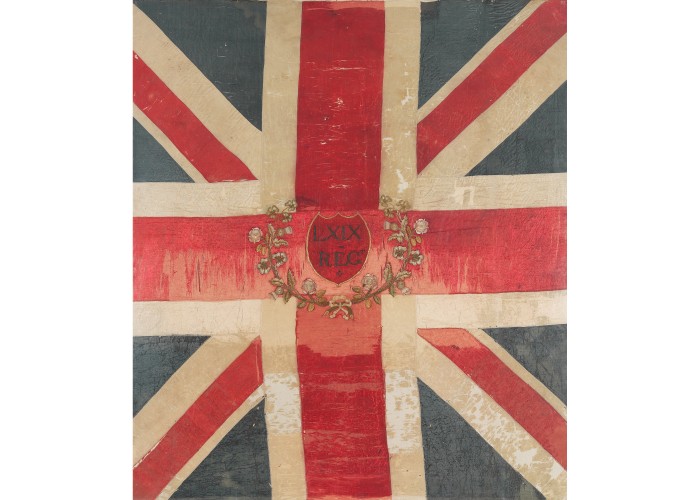Standard of the 69th Regiment of Foot
This is the King’s Colour of the 2nd Battalion of the 69th (South Lincolnshire) Regiment of Foot, who fought at the battles of Quatre Bras and Waterloo. At Quatre Bras, two days before Waterloo, they suffered terrible losses retreating from a French cavalry charge, and this regimental standard was captured by the enemy.
The loss of the 69th Regiment’s King’s Colour at Quatre Bras was a terrible dishonour. However, the much-reduced remainder of the 69th fought bravely at Waterloo, eventually recapturing their Colour after the Allied victory.
After Napoleon’s unexpected return from Elba in 1815, the British Army scrambled to assemble enough troops to fight against the French. Many veteran units had been sent overseas to protect the British Empire. The 69th (South Lincolnshire) Regiment, then stationed in Holland, was extremely inexperienced. The average length of service amongst the privates was only 3½ years, less than any other British regiment at Waterloo. The average age was just 21 years old, with over a quarter of the men aged 15-19.
Before the Battle of Waterloo the 69th were stationed south of Brussels, near the crossroads of Quatre Bras. Here on 16 June Dutch & British fought the vanguard of the French army. Both sides suffered heavy losses of over 4,000 men, and the Allied army was forced to fall back towards Brussels, planning to make a stand at Waterloo.
During the battle of Quatre Bras, the 69th were charged by a mass of French cavalry. They attempted to form up into squares, with their bayonets pointing outwards. This formation was almost impossible for cavalry to attack, as their horses would refuse to charge onto a mass of spear-pointed bayonets. However, possibly due to confusing orders from their inexperienced commander the Prince of Orange, the 69th were unable to get into squares in time. Two companies were caught in the open, and hacked down by French sabres, almost to the last man.
In this slaughter, a French cuirassier (armoured cavalry soldier) cut down Ensign Duncan Keith, who carried the King’s Colour. This flag was personally presented to the regiment by the monarch, and served as a rallying point and source of pride for the troops.
The 69th suffered 38 killed and 115 wounded out of 546 men. At the Battle of Waterloo on 18 June, there were too few men to form a defensible square, and they were forced to join forces with the 33rd Regiment of Foot to fight.
At Waterloo, the 69th had their revenge upon the French cavalry, as the horsemen charged the British squares several times, suffering appalling losses from musket- and cannon-fire. Captain Alexander Mercer of the Royal Horse Artillery said the French “were smashed to fragments” on the British squares “like waves beating against rocks”.
-
Education overview
Learn the story of Ensign George Simon Harcourt Ainslie, a soldier of the 69th Regiment of Foot, on the Waterloo 200 Schools E-Book. The Priory School have researched the life of this local Waterloo veteran and created a tribute to his service in the Waterloo Campaign.
If you’re a teacher, student, or parent, you can join the Waterloo 200 Schools programme. To find out how to sign up your class and discover your local Waterloo history, contact [email protected].
-
Curatorial info
- Originating Museum: Firing Line Museum of the Welsh Soldier
- Material: Silk
-
Use this image
You can download and use the high resolution image under a Commercial Commons licence, for all non-commercial purposes, provided you attribute the copyright holder.
- Rights Holder: Copyright Firing Line Museum of the Welsh Soldier
- License Type: Creative Commons
Find it here
This object is in the collection of Firing Line: The Cardiff Castle Museum of the Welsh Soldier








